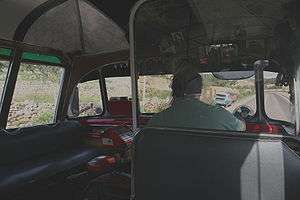Intercity bus driver
An intercity bus driver is a bus driver whose duties involve driving a bus between cities. It is one of four common positions available to those capable of driving buses (the others being school, transit, or tour bus driving).[1] Intercity bus drivers may be employed for public or private companies. It varies by country which is more common. But many countries have regulations on the training and certification requirements and the hours of intercity drivers.

In the United States, intercity bus driving is one of the fastest growing jobs, with attractive wages and good benefits.[2]
Duties
Besides the actual operation of the bus, duties of the intercity bus driver include cleaning, inspecting, and maintaining the vehicle, doing simple repairs, checking tickets of passengers or in some cases, collecting fares, loading passengers on and off the bus efficiently, handling the passengers' luggage, enforcing guidelines expected from passengers (such as prohibiting yelling), and dealing with certain types of emergencies.[3]
Good communication skills in the native language of the country and other languages spoken by a large part of the population are also key. Drivers must be able to engage in basic communication with passengers and to give them directions and other information they may need.
Some countries require intercity bus drivers to fill out logs detailing the hours they have driven. This documents they are compliant with the country's laws regarding the maximum number of hours they are permitted to drive.
Training
Intercity bus drivers are required to hold a Commercial Driver's License (CDL) with P endorsement. The requirements for this vary by country, but require more training than driving a passenger automobile. Safe driving skills and the willingness to obey traffic laws and handle driving under a variety of weather and traffic conditions are essential, as passengers expect a safe trip, and the safety of those in other vehicles on the road is necessary.
Those hired as intercity bus are often expected to have prior experience in the operation of a commercial vehicle. This may include the operation of a municipal bus service, school buses, or trucks.
New hires by companies are often oriented to their jobs by first riding along for one or more runs on a route, then driving the route under supervision of an experienced driver, or driving the route unsupervised without any passengers. After passing the training, most new hires will only work as backups until a permanent position can be offered.
Scheduling
Intercity bus drivers are provided with a lot of independence, though they are expected to follow a particular route and schedule as determined by their employer.
On shorter routes, it is possible for a driver to make a round trip and return home on the same day, and sometimes to complete a round trip multiple times in a single day.
On longer routes that exceed or come close to the maximum number of hours an operator can legally drive, drivers will be changed over the course of the route. Either the driver will drive half the work day in one direction, and switch places before driving part of a trip in the other direction on a different vehicle, or the driver will drive the maximum amount of time permitted by law in a single direction, stay overnight, and complete a return trip on the following day. When the latter occurs, the employer will often pay lodging and dining expenses for the driver.
An issue with intercity bus drivers, especially those on longer routes, is taking short breaks for eating and restroom use. Stopping to meet these human needs is a necessity. But making these stops delays the trip, which many passengers want to be as quick and efficient as possible. Often, the driver will pass these breaks onto the passengers and allow them to enjoy the benefits of the break as well.
Safety
Intercity bus driving is generally safe but carries its risks for drivers. Accidents occur, which can be harmful to the driver, passengers, and those in other vehicles involved alike. Dealing with unruly passengers can be another challenge, something which operators are not generally equipped to handle. Such passengers can be harmful to the driver and other passengers alike.
There have also been incidents which have occurred involving intercity bus drivers being assaulted by passengers. One such event occurred on October 3, 2001, when Damir Igric slit a Greyhound driver's throat, resulting in seven deaths (including Igric himself) as the bus crashed.
See also
References
- Eberts, M.; Gisler, M. (2008). Careers for People on the Move & Other Road Warriors. McGraw-Hill Education. p. 75. ISBN 9780071641999. Retrieved 2015-09-14.
- America's fastest growing jobs, page 33
- Careers in focus: Transportation, page 92